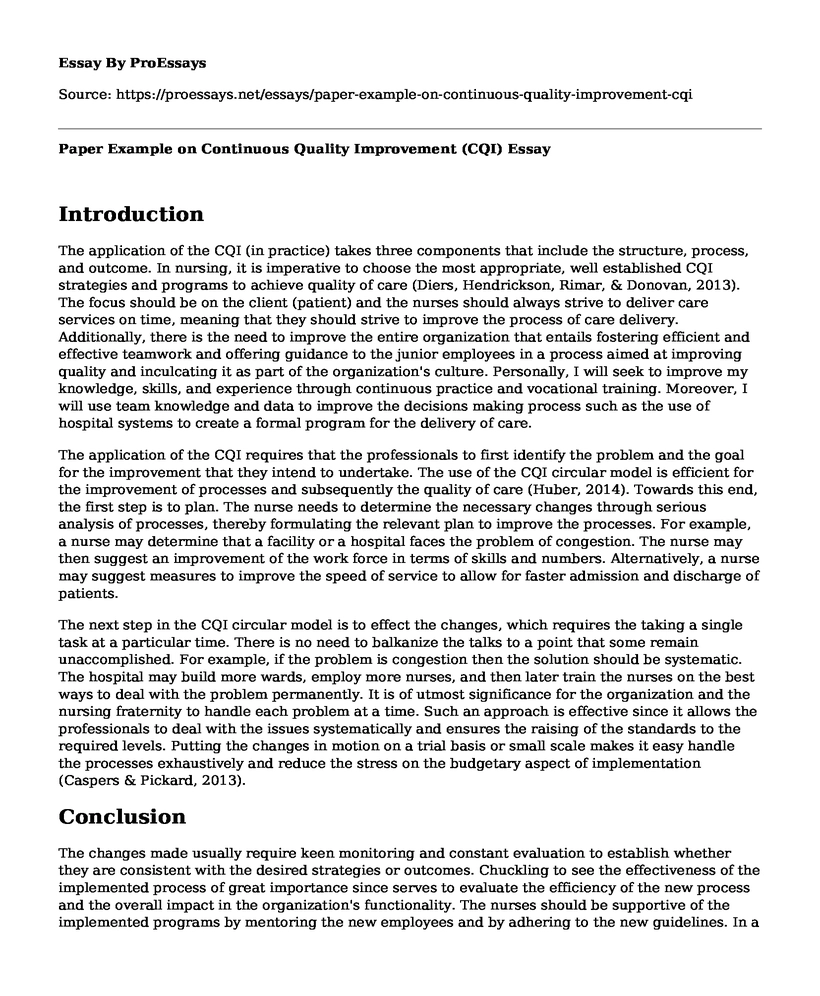Introduction
The application of the CQI (in practice) takes three components that include the structure, process, and outcome. In nursing, it is imperative to choose the most appropriate, well established CQI strategies and programs to achieve quality of care (Diers, Hendrickson, Rimar, & Donovan, 2013). The focus should be on the client (patient) and the nurses should always strive to deliver care services on time, meaning that they should strive to improve the process of care delivery. Additionally, there is the need to improve the entire organization that entails fostering efficient and effective teamwork and offering guidance to the junior employees in a process aimed at improving quality and inculcating it as part of the organization's culture. Personally, I will seek to improve my knowledge, skills, and experience through continuous practice and vocational training. Moreover, I will use team knowledge and data to improve the decisions making process such as the use of hospital systems to create a formal program for the delivery of care.
The application of the CQI requires that the professionals to first identify the problem and the goal for the improvement that they intend to undertake. The use of the CQI circular model is efficient for the improvement of processes and subsequently the quality of care (Huber, 2014). Towards this end, the first step is to plan. The nurse needs to determine the necessary changes through serious analysis of processes, thereby formulating the relevant plan to improve the processes. For example, a nurse may determine that a facility or a hospital faces the problem of congestion. The nurse may then suggest an improvement of the work force in terms of skills and numbers. Alternatively, a nurse may suggest measures to improve the speed of service to allow for faster admission and discharge of patients.
The next step in the CQI circular model is to effect the changes, which requires the taking a single task at a particular time. There is no need to balkanize the talks to a point that some remain unaccomplished. For example, if the problem is congestion then the solution should be systematic. The hospital may build more wards, employ more nurses, and then later train the nurses on the best ways to deal with the problem permanently. It is of utmost significance for the organization and the nursing fraternity to handle each problem at a time. Such an approach is effective since it allows the professionals to deal with the issues systematically and ensures the raising of the standards to the required levels. Putting the changes in motion on a trial basis or small scale makes it easy handle the processes exhaustively and reduce the stress on the budgetary aspect of implementation (Caspers & Pickard, 2013).
Conclusion
The changes made usually require keen monitoring and constant evaluation to establish whether they are consistent with the desired strategies or outcomes. Chuckling to see the effectiveness of the implemented process of great importance since serves to evaluate the efficiency of the new process and the overall impact in the organization's functionality. The nurses should be supportive of the implemented programs by mentoring the new employees and by adhering to the new guidelines. In a situation that the changes record positive results, the nurse should help the organization in the large scale implementation of the process. The nurse should also help refine or reject the process by advising the management on the perceived performance levels. Essentially, the goal is to improve and maintain quality through the application of acceptable, ethical, and professional standards, procedures, and processes (Andrews, 2013).
References
Andrews, D. R. (2013). Expectations of millennial nurse graduates transitioning into practice. Nursing Administration Quarterly, 37(2), 152-159.
Caspers, B. A., & Pickard, B. (2013). Value-based resource management: a model for best value nursing care. Nursing administration quarterly, 37(2), 95-104.
Diers, D., Hendrickson, K., Rimar, J., & Donovan, D. (2013). Understanding nursing units with data and theory. Nursing Economics, 31(3), 110.
Huber, D. (2014). Leadership and nursing care management (5th Ed.). Maryland Heights, MO: Saunders Elsevier. ISBN-13: 9781455740710.
Cite this page
Paper Example on Continuous Quality Improvement (CQI). (2022, Jun 05). Retrieved from https://proessays.net/essays/paper-example-on-continuous-quality-improvement-cqi
If you are the original author of this essay and no longer wish to have it published on the ProEssays website, please click below to request its removal:
- Why Burn Out Rates for Nurses Is So High and What Intervention Are Put in Place to Reduce It
- Essay Sample on Passive Smoking
- VA MISSION Act of 2018 Paper Example
- Essay Example on Johnson and Johnson's Pharmaceuticals
- Essay Sample on New Nurse's Challenges: Overcoming Stress in First Year of Work
- Essay Example on US Flu Surveillance Data Unreliable: Estimates Used Instead of Cases
- Essay Example on Aged People Suit Best in Upcountry: Physical Attributes at Play.







